Chapter 1
A Condo Owner's Guide to Guest Security and Safety
At some point, whether you're the type who likes to have company over or not, you will end up hosting a guest in your condo.
While they're in the confines of your urban home, you'll want to make sure they're well entertained and, above all, safe and protected.
Ensure the safety and security of your guests, and read on.
There’s no denying it: there are many benefits to living in a condo community. One of them is enjoying the luxurious amenities that come with your condo. On top of that, you can invite your friends or family over to enjoy these amenities with you or marvel at the relaxing view at your condo unit.
While inviting your loved ones to your condo sounds fun, though, you also have to consider many things before welcoming them on your turf. One of these is guest security. The reality is: bad people do exist in this world. It can be your neighbors, your neighbors’ guests, your own friends or family, or strangers who happen to pass by your property.

As a condo owner, it is important for you to enforce a strong guest security system. Such a system can help avoid unfortunate events from happening to your guests or to your condominium, like theft or trespassing. If you prioritize guest security at all times, you are sure to have yourself and your visitors protected at all times.
Want to start strengthening guest security in your condominium? Here is a quick guide on how to ensure guest safety and security within your property’s community before, during, and after your guests’ stay.
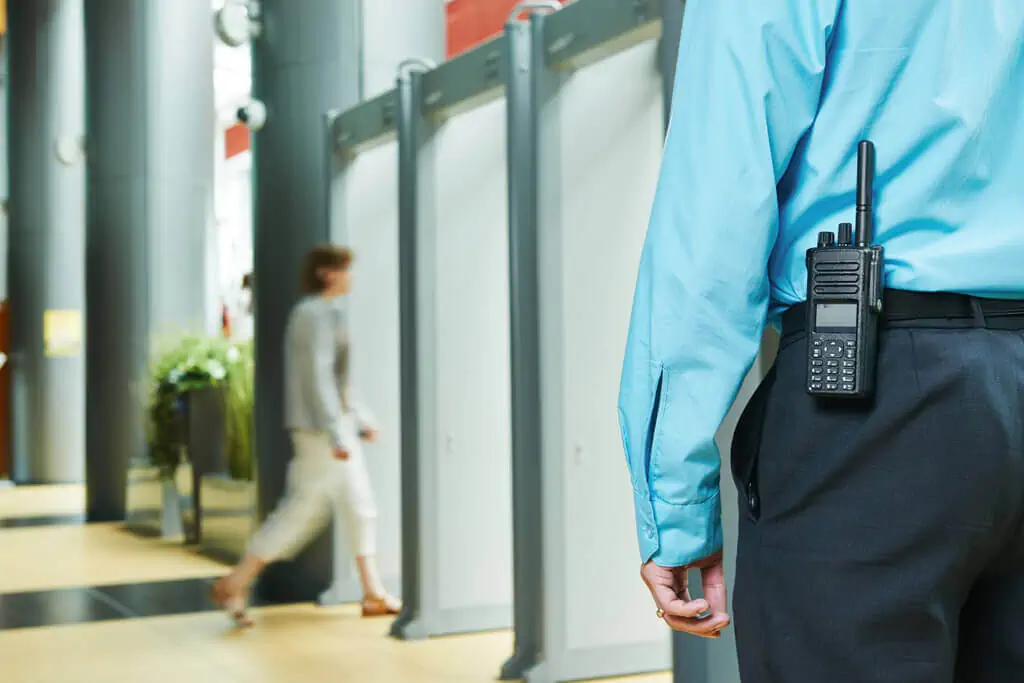
Before Entering the Property
- If they have a vehicle, inform your property security beforehand.
If your guests are bringing a car with them, it’s best to let them know of the type of car and plate number of their vehicle for faster validation and entrance. - Guests should be informed of your condo unit details.
Whether they’re entering the property in a car or by walking, your guests should know your full name, your building, and of course, your unit number. This is in strict compliance with the condo community’s security, and they don’t just let anybody in the property without the proper information. - Remind them to have a Valid ID in hand.
This is just a standard security protocol for condominiums in the Philippines. Your guest should be able to provide a valid ID before entering the elevators of your condo building. - Orient your guests about the condo rules:
Discuss the condo unit rules with your guests and explain them. However, please make sure to carefully choose the right words so that your guests won’t feel offended or uneasy while inside your condo unit. Don’t make them feel like they’re doing something bad or is suspicious—they are your guests after all. - Give emergency numbers to your guests:
You may not be with your guests, 24/7. If something terrible happens, they need to get help for themselves. As a condo owner, you have to provide emergency numbers to your dwellers for guest security. Place the list at a place where they can easily see it, like in the front door or on the refrigerator. - Check the condition of your security tools:
The good chances are, you already have security tools for your condominium. Whether you bought them yourself or the building administrators provided it, check these tools’ conditions before any of your guests arrive. This way, you can provide the best guest safety and security with tools that are working and not malfunctioning. - Know your potential visitors, first:
This isn’t required if they’re your immediate family or close friends. But let’s say they’re inviting someone new or not familiar with, then it’s best to ask your friends or family members about them, first. This way, you’ll somehow get some information about them.

During Their Stay on the Property
- Inform your building’s staff and security.
Your guest may be using facilities or going in and out of the property during their stay. Let the staff know that they are your guest, so unnecessary misunderstanding can be avoided. - Check on your guests every now and then:
It will help to check your guests, whether they’re only staying for the afternoon or for a whole three days to see if they are comfortable with the kind of accommodation you’re providing. This is also a nice way for you to find out if your guests are enjoying their stay and making them feel that you’re happy that they’re around and that they are welcome in your unit. - Remind guests to ask or report any issues:
Ask your guests if they notice any issue while they’re staying at your condo unit or the property itself. Should they notice any suspicious individual roaming around the community, tell them to inform you or even the community’s security and personnel. - Tell your guests to be mindful of their vehicle:
Make sure to assist your guests about condo parking space as soon as they arrive. Ask them to inform you a few minutes before they reach your condominium so that you could wait for them at the entrance and help them in parking their vehicle. This way, your guests will not have to wait for the security personnel to get your confirmation that they are your guests. - Address any reported issues by your neighbors:
You can always ask your neighbors for first-hand information if they happen to report your guests for any noise or unruly behavior. Then, solve the issue with your guests and talk to them immediately.

After Leaving the Property
- Remind guests to retrieve their Valid ID.
They may have a blast in your condominium unit, but remind them to get their valid id at the building lobby! - Exhaust all means to notify guests about any belongings left in the property:
Unfortunately, you might have guests who will forget some of their personal belongings in your unit. By all means, make every effort to contact your guests about their belongings and discuss with them how you can return them from your condo unit. - Always thank your guests:
Once your guests’ stay is over, remember to thank them. If they give comments, take note of these and hand these over to the guest safety and security team of your condo.
Providing guest security is not easy, but as a condo unit owner, you should take the necessary steps to maximize your community’s safety and security; so that you can also enjoy the benefits of these security measures.
Chapter 2
8 Security Systems That Indicate a Safe Condo Building
With how crafty criminals are nowadays, a quick search on crime rates in your condo's area is not enough to bank your safety on.
A condo should be well-equipped to detect the sneakiest of scoundrels with top-notch security systems.
Learn how to figure out if a condo has defenses against security breaches here:
When scouting for your next home sweet home, looking up crime rates in the neighborhood is a given. If, however, you’re moving into a condo, you need to include an extra precautionary step: i.e., determining the security of the complex.
The truth is, condos, just like any other neighborhood, are hot in the eyes of burglars and trespassers simply because it’s one huge trove of prized possessions. Although rare, you’ve probably heard of horror stories about ransacked units and owners feeling violated.
Not all condos provide the same level of security. If you want to have peace of mind throughout your tenancy, find a condo with strong security systems in place.
That said when going to unit viewings and checking out facilities, make sure to keep an eye out for these pieces of security equipment and operations before purchasing your first condo unit.
Security Equipment
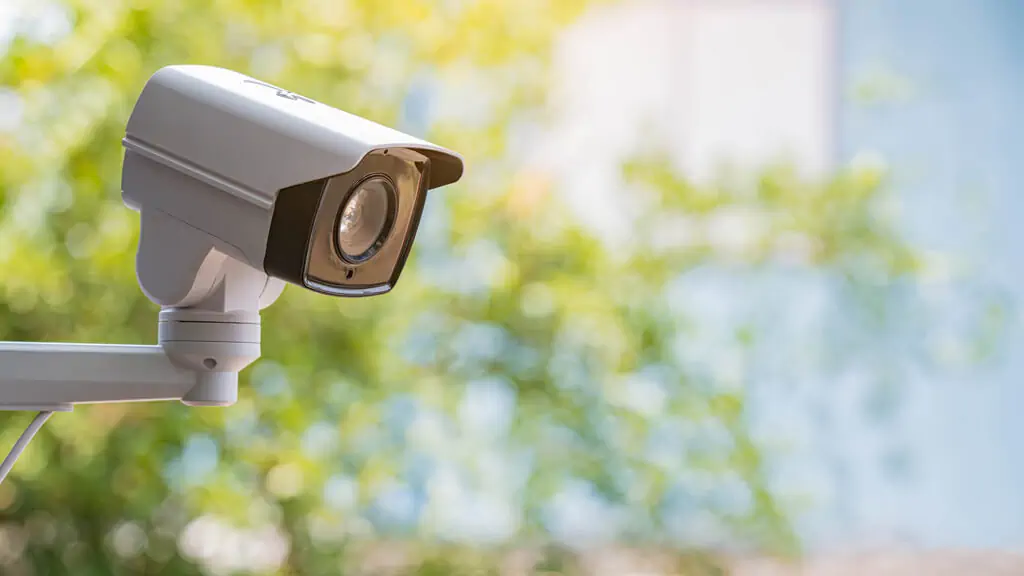
Condominium CCTVs:
- Make sure there are visible cameras. People are less likely to break the law when they know they’re being watched because the risk of getting caught is high.
- Check if the cameras are working. CCTVs that tilt or have those tiny red lights are a few visual cues that they’re on.
- Notice where the cameras are placed. Common areas such as swimming pools, playgrounds, laundry rooms, jogging paths, and basketball courts should have security systems with cameras.
- Ask if there are monitoring personnel behind those cameras. If, hypothetically, the police ask for footages, would the management be able to find and submit these?
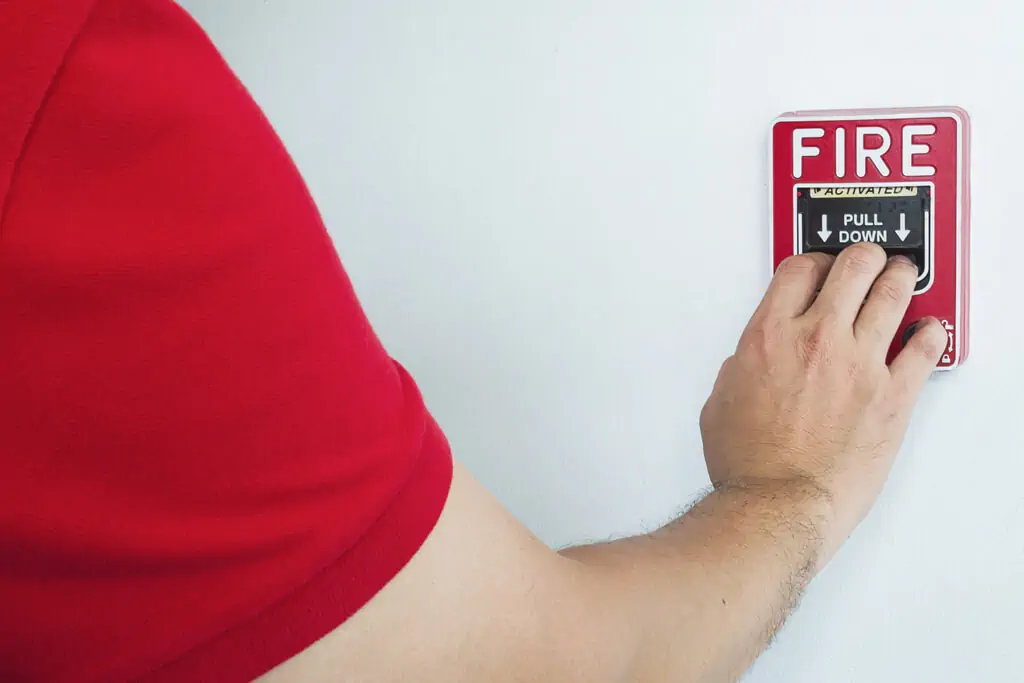
Condo Alarm Systems:
- See if the condo has security systems that alert you, should there be a break-in on the property. Some technologies are hooked up to the Admin’s monitoring room, allowing the condo management to send a team of security personnel to respond to the situation when the alarm goes off. Check if the condo has alarms that ring when there’s a fire or an earthquake.
- Check if the condo has alarms that ring when there’s a fire or an earthquake. Since man-made threats aren’t the only safety risks for residents, double-check if the condo community provides you with an early warning for your family will be able to better prepare in these situations. Recently, the House of Congress urged condo residents to make sure that their buildings have earthquake alarm machines, a requirement under the National Building Code. Apparently, some don’t have such. You may not want to skip over those options for the safety of your family.
- Ask for security protocols regarding the use of these alarms. No need for a lengthy discussion on the matter, just asking your security personnel on the common SOPs for you to have an idea what the management has lined up in case of any emergency.
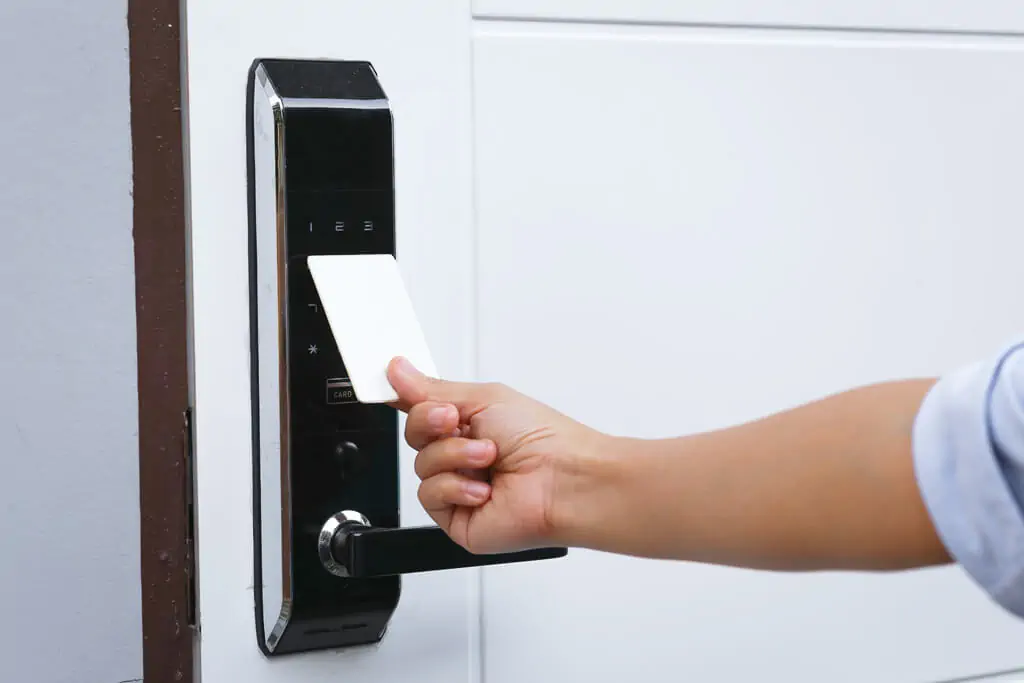
Condo Access Control Systems:
- Observe if the units have access control systems. This type of security comes in different types, but they do one thing: granting or restricting access to certain areas and/or certain people. It often involves the use of a card swiped or tapped to access pads to open electronically-powered doors.
- Check with the management if every use of the card is recorded in their computer system. This is important in the event of a break-in, as the Admin can run a search of where and when the card was swiped or tapped. Alongside the CCTV, it’s easier to see who tried to access units and shared areas.
Condo Intercom Systems:
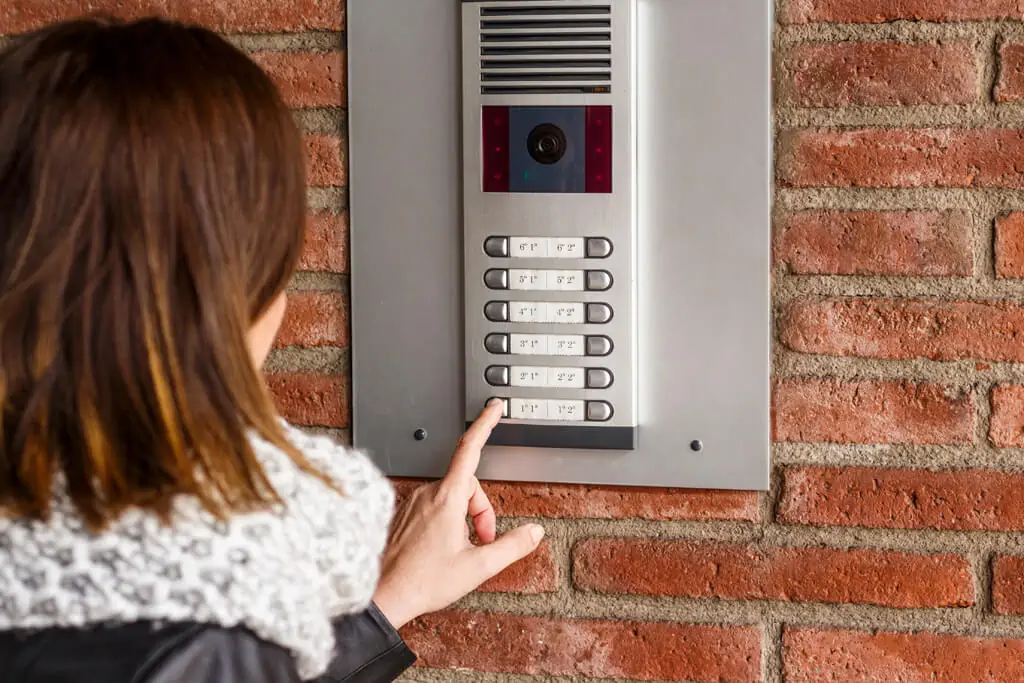
- Check if the condo units are furnished with intercom devices. Before, these security systems were simply audio-enabled. With tech advancements, though, it’s now possible to see who exactly is at your door, given the video capabilities of this equipment.
- If there’s an intercom, ask if it can be accessed through an app. With this feature, even though you’re at work, you can easily see people coming at your doorstep and report them to authorities, in case you notice suspicious activities. You’ll be able to monitor and protect your home while on vacation.
Condo Security Operations
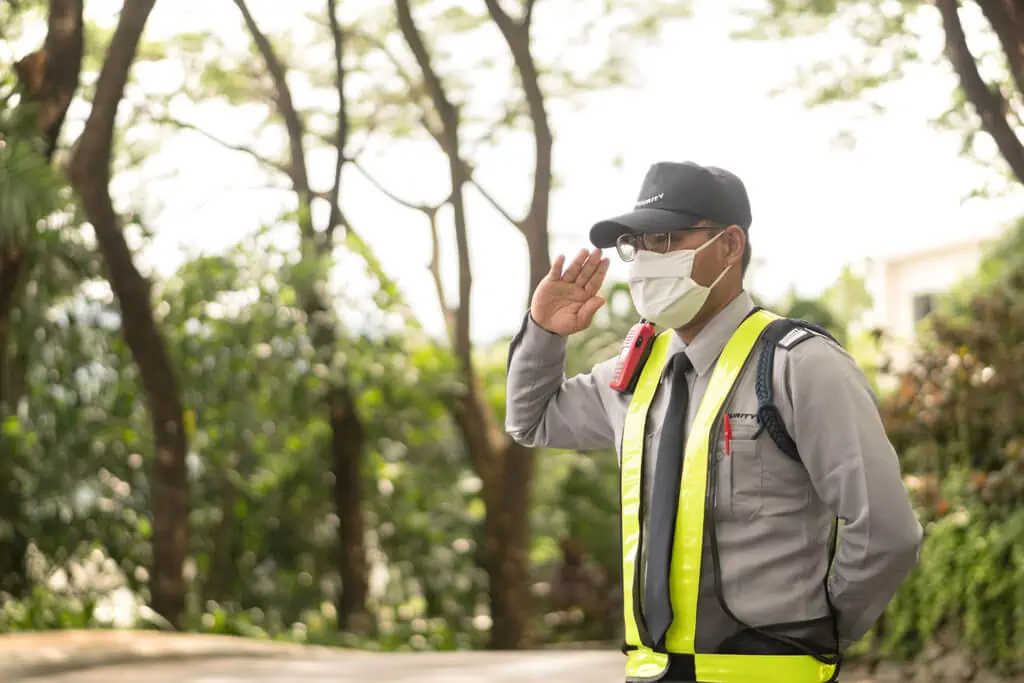
Roving Guards:
One of the reasons families opt for condo living is the constant presence of security guards at entry points. It is, however, not enough to settle with this security protocol. You should do these:
- Check if the guards actually patrol the area. Know that burglars rarely target randomly. They plan their move to reduce the risk of getting caught. When they stake out and see that there are uniformed officers going around the complex, they’ll most likely move to a more vulnerable neighborhood.
- Ask the Management how competently the roving guards respond to emergency situations. They should be able to catch trespassers or thieves, stop vandalism, or de-escalate brawls.

Front Desk Log-In/Log-Out System:
It’s inevitable for condos to have an influx of visitors throughout the day. From residents’ loved ones and friends to shopping or meal delivery personnel—the lobby can get flooded with all sorts of people.
The busy atmosphere makes the condo susceptible to criminals slipping through the crowds easily. The need for visitor authorization is then important in the security system. That said:
- Check with the condo’s reception how the staff goes about the log-in/log-out system. How strict are they in getting the personal details of everybody accessing the premises? What kind of information do they ask for and how efficient is the procedure?
Incident Report System:
- Aside from monitoring people, your condo must keep an eye out for incidents, too. With that, the Management can help the police in future investigations and establish better security systems to prevent it from happening, again
- Observe how Management encourages reporting. This move creates a culture of looking out for each other, which not only enhances security but also gives you more compelling reasons to live in the tight-knit community.
At the most basic level, the Admin should be able to make it easy for residents to report unpleasant occurrences. Ask about the standard procedure your condo's management follows.

Security Audits:
- Check if the Management organizes regular inspection and improvement of their security systems. Condo security isn’t a set-it-and-forget-it kind of thing. It requires tweaks every now and then, to make sure that it’s effective. In some condos, the Management hires third-party security experts to conduct an assessment, identifying weak points in the building security and testing protocols in place.
- Ask if the security personnel undergo training on local crime modus operandi and municipality ordinances. Educating the staff is one step to improving security systems.
It’s not enough to check the level of safety in the city you’re considering when buying your next condo. Rather, it's equally important to consider the security systems inside the complex itself. Otherwise, you might move into a place far from the home sweet home you’re envisioning. Grant your family the peace of mind they deserve.
Chapter 3
Safety Training for Condo Staff: What Homeowners Should Know
How would you feel if you came up to guard to ask them where the emergency exits are and they failed to answer you?
You would feel unsafe and want to get out of that unsecure place immediately, right? That's exactly why condos should invest in properly training their personnel for these kinds of concerns.
And what should they be trained for exactly? Here's a complete list to ask your building administration about:
There are countless perks to condo life. You get access to fun amenities and you’re surrounded by fantastic conveniences. However, there’s always a cause for worry, even as an apartment dweller. You never know when the unexpected will strike—from medical emergencies to natural calamities, you never know if or when these things will happen to you or your loved ones.
You don’t want to be a worrier, and you can certainly make your home family safety into your own hands. Are your apartment's staff and maintenance team ready as well, though? Do they have the safety training needed to ensure your security when disaster strikes?
There’s no need to worry as much when you’re working with companies like DMCI Homes. They ensure your happiness with premier safety training and operating procedures to uphold your protection and security. Staff and personnel are trained to respond fast when emergencies happen. You can review your condo homeowner's manual to see some of the security protocols they practice to keep you safe. Also, for your peace of mind, you can check out a few of their effective standard operating procedures below:
Constant Surveillance to Prevent Problems
The first and most important part of effective staff training for emergencies is prevention. Prevention through constant surveillance is key to keep emergencies from happening in your home.
Companies like DMCI Homes have guards who regularly patrol the apartment building. They also have lifeguards at pools keeping an eye on any possible problems. There are trained security personnel who keep an eye out for everyone and everything through security cameras strategically placed all over the apartment. All these people have medical experience, so if anything happens, they know what to do. With their staff training and development, they keep an eye on their tenants to keep you and your loved ones safe.
Fire Precautions and Procedures

Fires are some of the most common emergencies to happen in any condominium. DMCI Homes have up-to-date fire precautions and procedures that help them respond in case of such an event. Security personnel undergoes staff training to initiate smoke control and start-up emergency generators and exhaust fans in the unit. There are fire exits all over the building. As a tenant, make sure to take note of where these fire exits are located so that you know where to go in case of such a problem.
As a tenant, you can also take some condo safety measures into your own hands for yourself and your loved ones. Aside from knowing where to find the emergency exits, familiarize yourself with the locations of nearby fire alarms and fire extinguishers. Know where the evacuation area is after exiting the building. Keep in mind what valuables you’ll need to bring if a fire does break out in your apartment. Most importantly, ask the well-trained staff for help. They can help you with all these measures and ensure your security in case of such an incident.
Earthquake Precautions and Evacuation Procedures

As a condominium dweller, the scariest emergency that could happen might just be a calamity. It’s terrifying to think of what could happen to you if you’re in a high-rise building during an earthquake. Some people tend to think twice about renting because they worry that they won’t be able to withstand such a natural calamity.
But you have nothing to worry about with DMCI Homes. As the first developer in the country with a quadruple A license, DMCI Homes builds the highest quality condominiums to ensure the security of their tenants. They have a great track record as developers and experts in the industry. They design their buildings with measures in place and review their specifications every few years to stay up to date with the necessary protocols.
You can also be assured of your peace of mind every day of your life with the help of the trained personnel of DMCI Homes. They have safety training for employees, especially regarding disaster response. Every staff member knows the "stop, drop, and hold" procedure for earthquakes so they know how to provide clear instructions. They can guide you to emergency exits and will prioritize your life above all else. They also know how to provide first aid in case anything happens to you or your loved ones during an earthquake. That said, the personnel in any DMCI Homes building can ensure your security during earthquakes.
Your security is the staff's number one priority at any given moment. Their safety training is there to ensure your happy apartment life. As a tenant, you can practice safety measures for calamities and other emergencies. You can enjoy your condo life knowing that the staff members in your condo community are always watching out for you, especially when the unexpected happens.
Chapter 4
Secure Your Condo Unit With These Helpful Tips
Condo security may sound like a job reserved for the building administrators and the security personnel to do, but it's really not just up to them.
Safety and security inside condominium buildings are just as much your resonsibility these days, and watching out for each others' backs isn't that hard to do considering the big pay-off in doing so.
Here's how you can pitch in and take charge of condo security in your own little way:
With today’s congested roads and overpopulated public transportation systems, commuting in Metro Manila on a daily basis has become a living nightmare for many Filipinos. This is why many have opted to live in condominium units as it is more convenient and accessible to live in, without having to deal with hours and hours of terrible traffic.
More and more people are being drawn to the benefits of condo living, which is why ample condo security measures must be followed in order to ensure a comfortable and secure condo living—even within the metro.
While Metro Manila saw a six percent decline in crime volume for 2019, you shouldn’t be complacent with the safety of your condo unit, and the family living in it.
In keeping the condo unit and building safe, there are many people involved. From the condominium personnel, the staff, the condo security guards, and even the residents. And in the event of a security risk, these parties must also team up to resolve the issue
So how do you keep a condo community secure? Here are some ways you can do it.
Before Entering the Condominium:
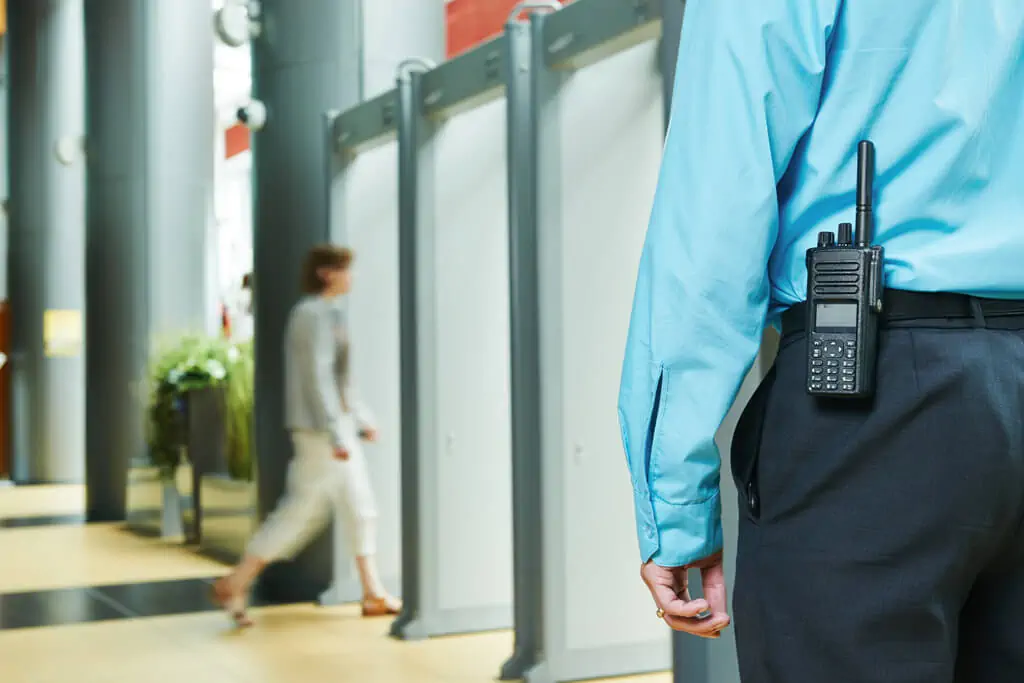
- Strictly follow security checks:
Considering that many families and people now opt to live in condo units, countless people enter and leave the building, making it vulnerable to possible burglary and other related crimes. No matter how much the security team knows you, always follow security checks necessary before heading inside the condo. - Survey the people in the lobby:
You may remember the people in your building well since most of you come across each other from time to time. If you meet an unfamiliar person with very suspicious actions, take extra precautions, and report it to the security on duty. - Survey the surroundings:
As soon as you reach the unit, before opening the lock, take a good look around you if there are any suspicious persons around watching. And when you open your condominium door, remember not to fully open it so that no one would get a glimpse of what is inside your unit.
While Inside the Condominium:

- Remain aware and vigilant:
When going around the facilities of the building remember to remain vigilant and keep an eye on your belongings and never leave them unattended. You’ll never know when security breaches happen. - Protect your condo privacy:
The thing about high rise condos is that you can be seen from other buildings. Decrease the vulnerability of your condo unit by keeping your window curtains closed at all times. This can prevent anyone from getting a glimpse of your unit, which might entice burglars. - Double-check your valuables:
Before coming in and out of your unit, consider going for a quick inspection to see if everything is in place. When you come back and something is off with how you left your home, then it’s time to call the condo security. - Hide your important documents:
One of the many things that burglars attempt to steal from your home is your important documents like credit cards, insurance documents, and passports. Secure these files in your condo by keeping them in places they are less likely to be found like a medicine cabinet or under a pile of unused clothes. - Keep your condo out of social media:
While we like to share our lazy day photos via Instagram stories, these can give burglars an idea of your floor plan as well. Stay discreet and do not post the interior of your unit on any social media site, even if your account’s private.
When Leaving the Condominium Unit:

- Inform the condo security team of your absence:
The condo unit is at its most vulnerable when it’s unmanned. And it’s the condo security team’s responsibility to keep an eye on the unit when you’re not aroundA way to subtly inform the security team of your absence is to sign their log or wave a simple goodbye. This way, they’ll be informed that you have left the facility. - Take the call if you’re not accepting visitors:
Burglars might pretend that they’ll be paying you a visit or claim that you asked them to keep an eye on the unit. Be wary of these attempts by declaring that you’re not taking any visitors while you’re away. This way, no one can come near your unit except you and the condo security. - Have someone keep an eye on your unit:
If you trust your neighbors enough, you can inform them of your absence and ask them to look after your unit. Apart from the security personnel, you have additional eyes on your home. Only do this when you know your neighbors enough to entrust them with such responsibility. You can also include them in your emergency contact list, just in case.
These are just some of the ways you can secure your condo from theft. You can also consider amplifying the security of your unit by investing in these tools:
- Alarm systems:
Alarms can trigger high pitched noise that can warn the security team of the break-in. You can also have these connected to the building’s monitor room for quicker responses. - CCTV cameras with live footage:
Condo security cameras or CCTVs are one of the best gadgets to secure your condo unit from vulnerability. With your smartphone, you’ll be able to keep an eye on your home wherever you are in the world through a live feed.
While condo security is the job of many parties—condo personnel, security guards, and staff—it is also the responsibility of the residents to secure their homes. Following the necessary security measures in your building, plus your own security efforts will make condo living a breeze.
Chapter 5
Top 4 Things You Need on Your Facilities Checklist
Safety and security isn't just a question of protection against external forces like burglars and other evils but also one of internal safety implements.
Accidents often come out of nowhere and in the places you least expect them, like the common areas you share with other tennants.
To know what to check in terms of safety implements in shared spaces in your condominium building, read on.
Condos are amazing and safe places to live in. There are tons of conveniences around you, you have access to great amenities, and you’re surrounded by a welcoming condo community. But no matter how wonderful your condo life is, you’re still surrounded by possible accidents, emergencies, and dangers. It’s important to know how to secure yourselves in your condo life, especially if you’re living there with your loved ones.
You need to start taking condo safety measures today by securing your unit with facilities checklist. Fix key locations on this list and give yourself peace of mind, knowing your loved ones are safe. Here are some key locations that you need to secure:
Elevators
Everyone who enters a condominium will pass through the elevator. With the number of people who pass through the elevators every day, they’re at risk of accidents and unsafe situations. Go through this elevator safety and security checklist to ensure peace of mind.

- Check if there are security cameras placed:
See if they’re functioning cameras by checking with the security desk, and see if there’s also a guard who watches through regularly. This should be one of the first things you look at in your condo checklist. - Make sure that there’s a working intercom with a labeled emergency button:
Next on your facilities assessment checklist is the intercom. Ask the building’s management if you can test the button and the intercom. That way, you’ll know if you can rely on them in case of an emergency. - See if there’s a quality assurance notice posted on the elevator’s walls:
This shows that the elevator was recently tested and secured by its manufacturers. Make sure to accomplish this on the building facilities inspection checklist. - Ask for regular elevator maintenance:
Have a quick chat with your condo building’s staff to ask if the elevators are regularly maintained. - Check on the elevator’s performance:
As someone who uses the elevator regularly, you may have an inkling when something’s wrong or feeling off. If you do, don’t hesitate to inform the condo property management or staff.
Emergency Exits and Staircases
The next places you should secure in your facilities maintenance checklist are the emergency exits and staircases. Take note of these home safety tips for a safer condo experience.
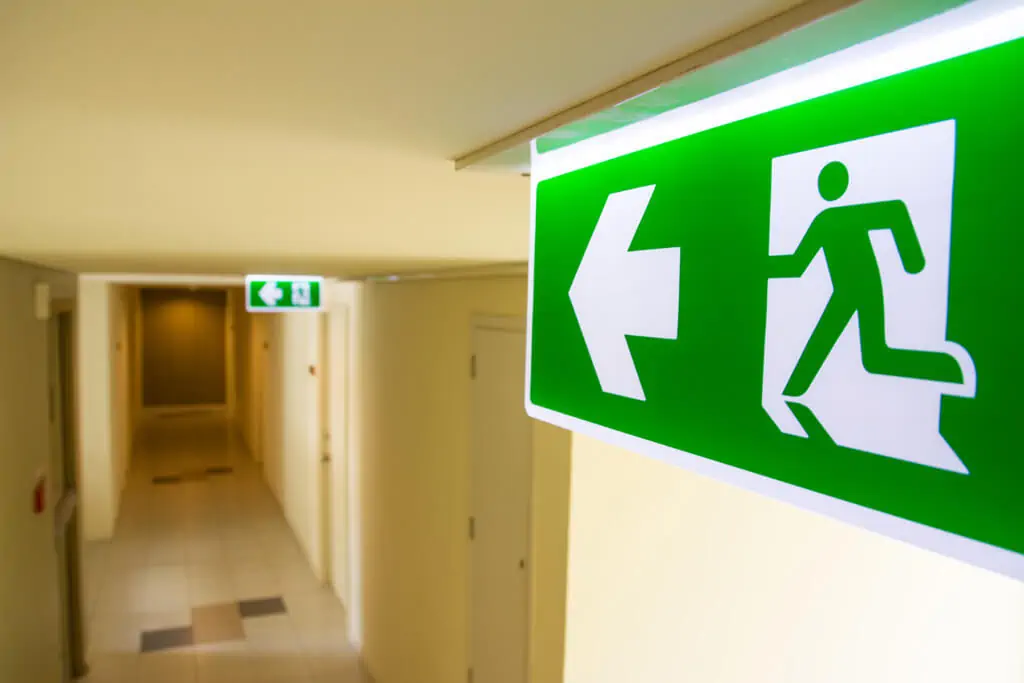
- Emergency exits should be properly marked and lit:
Find the emergency exits and know exactly where they are in relation to your unit. Ensure they’re clearly marked and see if the staircases are properly lit at night so that you can navigate them even when it’s dark. - Check if the exits are open for use:
Whenever you pass them by, test the emergency doors if they’re always open and available for use. This is imperative for your condo home inspection checklist. - Be aware of the fire escape plans:
Familiarize yourself with the fire escape plans posted around the complex. Have your own escape route from your unit, to the emergency exits, to the evacuation areas outdoors.
Amenities and Facilities
The great thing about your condo investment is that you have access to fun amenities like swimming pools, gyms, and many others. But for your peace of mind, keep an eye out for the little things that may be wrong on this checklist for facilities management.
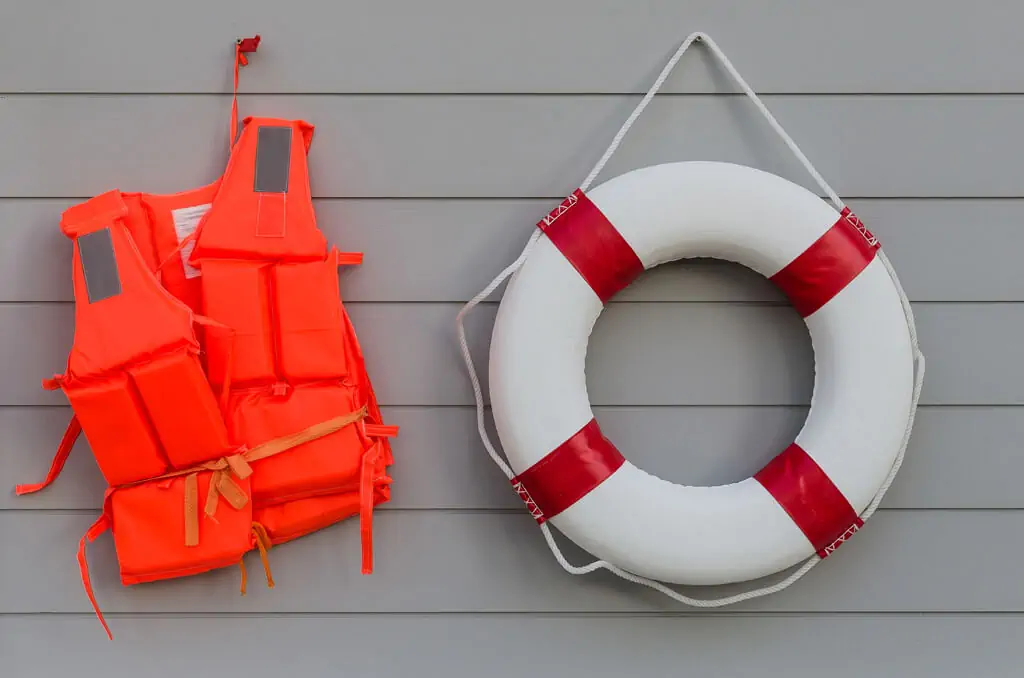
Condo Pool Area
- Check if there are lifeguards or staff watching over the pool at all times:
Swimming pools are just part of the many amenities in condo living. Check if there are lifeguards or cameras in place, just in case any accident occurs. - Look closely if there are broken pool tiles and lights:
Swimming pools experience wear and tear; it’s normal. But refer to your facilities inspection checklist and take a look if the pool has some missing tiles, broken tiles, or faulty water pump. It might be a sign that it’s not being maintained. - Know when and how your pool is being maintained:
No need to be a pool expert to know how well the maintenance is going. Just take a look at how often it’s being cleaned by the staff, or if it’s looking spiffy for everyday use.
Condo Gym
- Look at the quality of the gym equipment:
If the barbels are a bit rusty and the treadmill has a squeaky sound then better double-think if it’s safe or not. - Check for burnt-out light bulbs:
When working out, you should always be aware of your surroundings. Things might get blurry, or even dark if the lights don’t work. - Take a look at the shower and changing area:
Leaky bathroom facilities are telltale signs of inattentive building management, and they may lead to bigger issues in the future.
Common Area
- Check if security guards regularly check the area:
If anything untoward happens in the study area, you can at least be assured that a security guard will be there to respond right away. Keep this in mind on your home safety and security checklist. - Check if the lighting is okay:
This may seem like a little thing, but having good lighting while studying can positively affect your learning experience. This is important for students in study areas. Make sure that the management provides good lighting for you so that you can study well in the study area.
Watch out for these little signs of danger or inattentiveness in the amenities and facilities of your home, and report them immediately if needed. These things may seem little, but you shouldn’t overlook them for your ultimate home experience.
As a tenant, you have the right to great service. Keep these on your condo maintenance checklist so that you can be assured of your protection. There are lots of perks for condo dwellers, but again, you can never be too careful.
You need to have facilities checklist that’ll help you achieve security at home though because your home isn’t exempt from emergencies.
Chapter 6
A Homeowner's Guide to Earthquake Safety and Other Natural Disasters
"You often hear it said that you can avoid panicking in a situation if you've done your best to prepare for it.
Although they are the most unpredictable of situations, disasters are situations you can prepare and train for so you and your family can manage yourselves well in the event that they happen.
Learn how and what to prepare when a disaster or accident occurs in your condonminium's area here:"
Natural calamities are very unpredictable, which is why we need ample preparation. But the question is, how ready are you and your family when disaster strikes? If your family is not yet disaster-ready, don’t worry. Here is a complete homeowner’s guide to earthquake safety, fire safety tips, and flood safety precautions.
In this guide, you will learn general safety tips to do before and after any disaster. But since different disasters mean different safety measures, the list will give you specific instructions on earthquake safety precautions, flood safety measures, and fire safety rules at home.
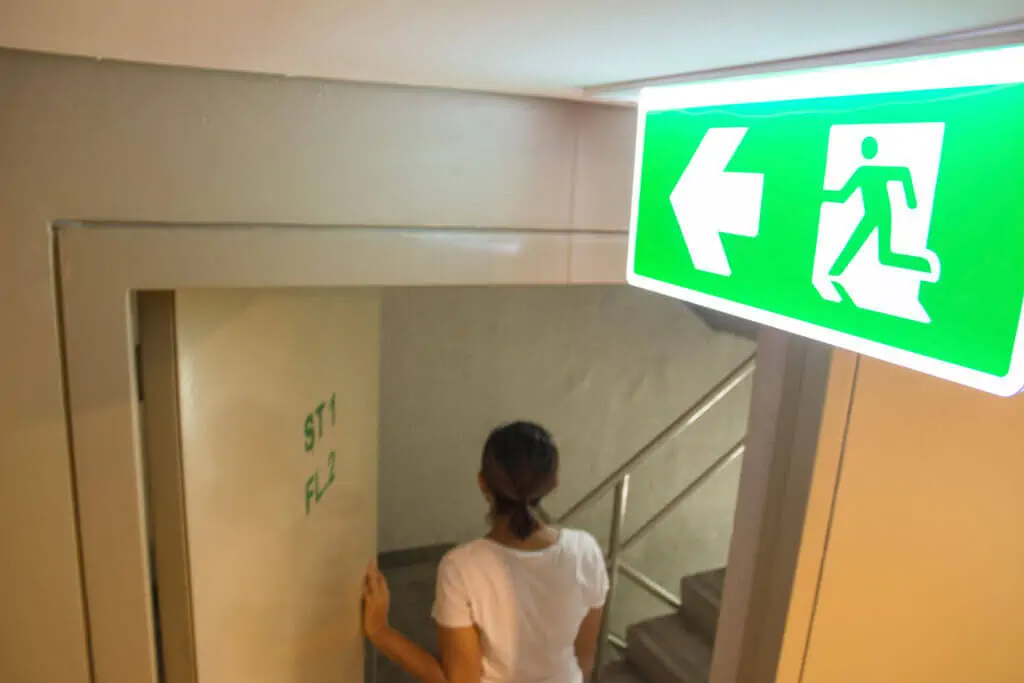
Before a Disaster
- List emergency numbers to call.
It’s a basic safety rule: prepare a list of emergency hotlines, including phone numbers of relatives residing in another town or area. Place this list on your refrigerator, main door, or wherever it is easily seen and accessible. - Create an emergency meetup plan.
Discuss all possible places where you and your family can meet up, in case you and your family are not together during a disaster. Don’t forget to evaluate your emergency plan and chosen the site’s safety, too. - Determine escape routes in your area.
Depending on the disaster, make sure you and your family know the emergency exits in your building. It’s good to also do some training with your family in locating these escape routes. - Take an emergency first-aid class
Undergo safety training for your family, like first-aid or CPR training with Philippine Red Cross. You never know when someone in your family, or even community, might need it during the disaster. - Have disaster supplies ready.
Get your safety kit ready in one bag, together with food supplies and photocopy of your vital documents. These documents may include your birth certificate and passports for identification.
Earthquake Safety Tips
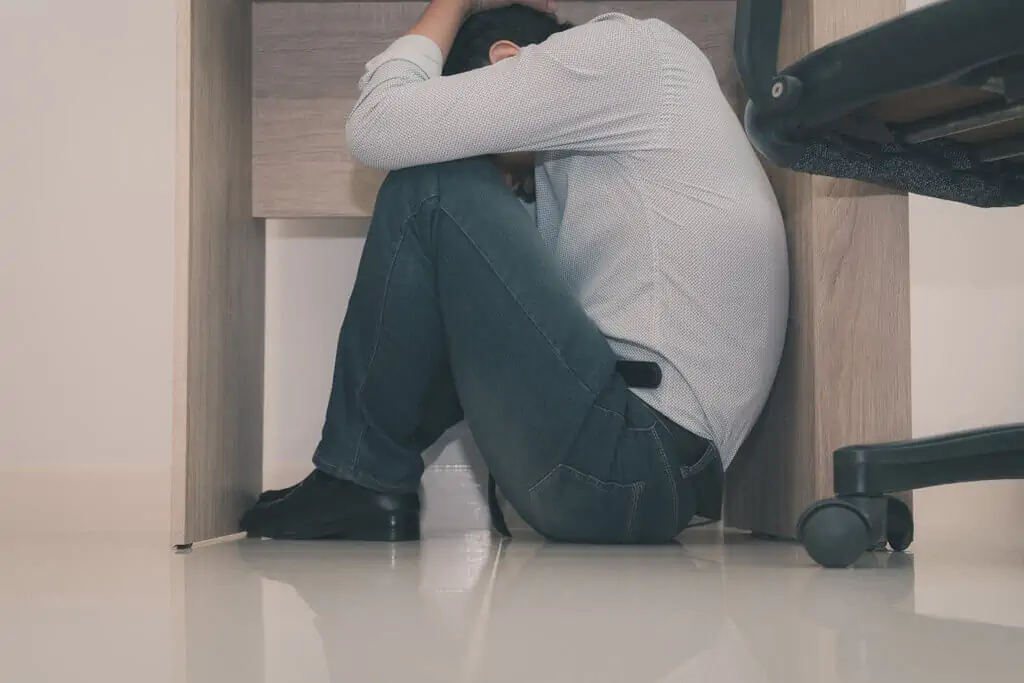
- Do the drop, cover, and hold.
Once you feel that an earthquake is happening, quickly do the drop, cover, and hold correctly. As a basic safety measure, stay where you are until you’re sure that the shaking has stopped. - Avoid standing in doorways.
While you may have a strong door frame, it cannot protect you from objects that may fall on other sides of your condo. - Hold onto your “shelter.”
If you are under a table or chair, one of the earthquake safety precautions to follow is to hold onto these objects. Hold them firmly so that they protect you well during the shaking. If you are in bed, stay in bed. You may feel helpless and scared, but it’s better to stay in bed for your safety. Just lie face flat on your bed while covering your head with a pillow.
Fire Safety Tips

- Shout or ring the fire alarm in case of a fire.
hout “Fire!” to wake up everybody in your family, even your neighbors. Ring the fire alarm immediately so that your condo’s authorities will be alerted. - Do not attempt to use the fire extinguisher if you don’t know-how.
If you don’t have fire safety training, don’t even attempt to put out the fire or use the fire extinguisher. Just leave the firefighting to the experts, and flee the scene immediately. - Open doors slowly.
For home fire safety, always be cautious about opening the doors whether the doorknob feels cool or hot. Open the door slowly while staying on the other side, so that you don’t inhale the smoke or get exposed to flames. - Stuff clothing or towels to keep the smoke out of your room.
Smoke inhalation is one of the causes of fire-related deaths. So for your fire safety, stuff clothing or towels in the spaces of your door to keep the smoke out of your condo. - Crawl your way out.
One of the fire safety measures to follow is always to crawl rather than walk or run. In this way, you can avoid smoke, fumes, or gasses that are surrounding the ceiling of your building.
Flood Safety Precautions
- Stay indoors as much as possible.
For flood water safety, just stay within the comfort of your home. Don’t attempt to go out anymore or check out how high the flood is. - If you have to walk in floodwater, use a stick.
But if you have to wade in floodwater for some reason, bring a walking stick with you. Use it as a safety measure to check for possible holes while you walk. - Wash your feet with soap and water as soon as possible.
Always wash your feet with soap and water once you’ve gotten out of the floodwater. It’s one of the basic flood safety measures that you must adhere to at all times. For extra safety measures, you can also put rubbing alcohol as well. - Wash your clothes in hot water.
Aside from your feet, make sure to clean your soaked clothes, too. Follow this basic safety precaution to get rid of the germs brought by the floodwater. - Stay away from electrical equipment.
If you see any electrical equipment that is submerged in floodwater, move far away as possible as a flood safety precaution. Don’t risk getting electrocuted.
After a Disaster
- Check for any injuries in your family.
Ask your family members if they are feeling something different in their body or if something hurts. Make sure to put your safety training to practice, too, in case someone is injured. - Follow disaster instructions of authorities.
If authorities still need to evaluate your site’s safety, then, by all means, follow any instructions that they will give. Evacuate if you must from the ruined site. - Remain calm and patient.
Panicking and running in different directions will get you nowhere. For your overall health’s safety, take deep breaths, and try to remain as calm as possible after what has transpired. - Wear protective clothing.
Once the coast is clear, don’t forget to wear protective clothes like sturdy shoes and hard hats if you have them. It’s for your own safety, from possible falling debris and flooded areas. - Talk to your family members about the event.
Disasters are traumatic events that might take a toll on any of your family members. Find ways to cope with disaster trauma, such as talking to your relatives and seeking professional help if possible.
In times of calamities, it is better to be over-prepared rather than to be underprepared. Being over-prepared can help prevent injuries in your family, and lessen any time on worrying about the condition of each family member. If you are over-prepared, you are at least confident that your family members know how to bring themselves to safety even if you are not together.
Chapter 7
A Quick Guide to Bedroom Safety for All Ages
Family members, no matter what the age, are prone to accidents even in the bedroom.
Yes, that bed may look super cozy, but that doesn't mean it is exempt from causing harm.
Read through these common accident-proofing tips for your bedrooms to make sure that it's safe for all ages:
As soon the day ends, no matter what age, everyone goes back into their comfortable space to decompress and the bedroom is one of those places everyone heads back to. It’s natural to just relax.
Some people find themselves even doing some of their work there and never leaving the room. Because of this, the bedroom became an integral part of one’s lifestyle and it is important to make sure that every nook and cranny of the room is safe. What better way to relax than knowing that bedroom safety is displayed in your comfort zone.
If you’re a little bit lost as to how exactly you can safe proof your room as well as theirs, check out this bedroom safety tips based on one’s age:
Infants (0-1-year-old)

Just because babies couldn’t walk yet doesn’t mean that they can just be placed in any room. Having an infant safe home is crucial and will put any parent’s mind at ease. The rooms they sleep in should be a lot more safe and comfortable.
- Make sure the crib is sturdy.
Babies tend to move around a lot, so make sure the crib is sturdy and stable enough for any ruckus here and there. - Don’t fill the crib with too many pillows or toys.
We want our baby beds to be soft, but having too many pillows may cause your baby to suffocate with all the fluff going on. - Baby monitors should be away from the crib.
As much as you want to hear the baby’s sounds, keep about 1-2 centimeters away from the crib, just to be safe. - Windows should not have any covers involving cords or strings or ropes.
Avoid any tangles or mishaps; don’t use strings or ropes for your windows. - No toys that are meant for over one-year-old in the room.
To keep the infant safe in the bedroom, don’t place any big boy toys just yet. Bring them back to the proper age. - Make sure you cover your floors.
Having mats for crawling and exploring is the perfect way to cover your floors and keep any accidents at bay.
Toddlers (2-5 years old)

Your baby at this age has probably learned how to walk, which means that anything at this point in time, they will try to reach out to. Toddlers during these times are very curious; they like to see, smell, taste, and touch different things. This is why their room needs safe-proofing.
- Always remember to have your electrical outlets covered.
This is the age of exploration but make sure they’re safe from any possible electrocutions. - Cover any sharp edges.
Toddlers might not have the hang of walking just yet. Cover sharp edges because you never know what they might bump into. - Don’t have any breakable items.
Avoid any further injury by keeping all breakable stuff and glass items away from a toddler’s bedroom. - Remember to not have any items near the edges of shelves or tables.
Some toddlers play rough for their age, so don’t risk any falling items by keeping them as far from the edge as possible. - Stowaway electrical cords.
Just like electrical outlets, you wouldn’t want any tangles happening any time soon. - Install a mini-gate/fence to keep your baby from going into areas that might be dangerous to them.
For an extra toddler safety measure, create fences for them to know what areas are safe to play around and what is not.
Kids (6-12 years old)

Kids at this time could already understand basic concepts, procedures, and methods. So, if you teach them certain safety scenarios, they will be able to understand and not so easily get distracted as you teach them. Make sure to let them know the importance of having a kid-safe home. Also, take the time to explain safety instructions to your kids, and when doing so, use words they could easily understand. You can do a role-playing scenario to demonstrate to them these safety procedures so that this will be ingrained in their minds.
- Make sure you have emergency telephone numbers written on and stuck on the wall.
Kids at this age can most probably read, write, and operate a mobile device. Teach them how to call emergency numbers if there’s any trouble happening. - Have safety guards for your windows.
Windows, especially condo windows, are not as safe as they appear - Change their bed according to their size.
Your child is growing each year, and should their bed. Keep safe and comfy by adjusting their bed accordingly. - Make sure doors don’t have locks yet.
As much these kids may want privacy at a young age, we never know what may happen if they’re alone in their bedroom. Best to be safe and not let them lock up by themselves.
Teens (13-19 years old)

Teenagers already know the term responsibility. Unlike kids, they’re young adults, which means they could be left at home alone.
Since they are young adults, you can just easily demonstrate to them safety procedures and they will understand it. They sometimes need constant reminding but nonetheless, they are able to fulfill their responsibilities especially when it comes to managing their own rooms.
- Make sure the electrical outlets are safe by having it checked at least once a month.
Teenagers use multiple gadgets, sometimes even all at once. Make sure to check on their outlets to see if they left any chargers or maybe even damaged outlets. - Make sure the flooring doesn’t have any rough/sharp surface.
Even though they’re adults, a rough or sharp surface can still cause unforeseen injury. - Dust your window curtains on a daily basis.
Whether your teens have allergies or not, proper dusting avoids the accumulation of dust. - Heavy items should be on the lower shelves.
Teens own their own stuff but make sure to keep the heavy ones near the ground to avoid any hard fall or injury.
Adults

You can’t be too sure sometimes, and when it comes to different situations, even as an adult you still have to be careful and safe-proofing your room is no exception
Following general home safety procedures is important to put your mind at ease. It’s imperative to remember that safety is always a priority even in the comfort of your own home because you can never be too sure.
- Have different compartments available to keep your items.
It’s as simple as not placing your lotion in the same compartment as your electronics. Have a designated compartment for each group of items you have. - Make sure the room is well lit.
Good lighting can help you see and navigate through your bedroom properly. No more unnecessary tripping into one of your shoes! - Replace any bedroom appliance that has damaged cords.
You can DIY those broken wires with electrical tape, or you can bring them to a technician for a quick fix.
Seniors (60 years and above)

Home safety for elderly adults is just as important as having a kid-safe home. Senior citizens don't have the same agility as they once did. It is important that as they move around their room, they are safe to avoid any unnecessary accidents that might be detrimental to their current health condition.
- Make sure their bed provides proper support.
Elderly people have special needs, especially when it comes to their health. Give them proper sleep by providing the right bedding support. - Make sure the room has handles to help them walk.
If your elderly walks with a cane or is in a wheelchair, place grab bars for them to hold onto to avoid tripping and falling.
Overall, getting the habit of constantly checking your electrical systems, your flooring, corners of your room, edges of your furniture, and all the other aspects, allows you to develop a sense of awareness and cautiousness. You can be certain that every time you check your room, you will be able to maintain their good condition.
Chapter 8
Top Balcony Safety Ideas for Condo-Dwellers
This may not need spelling out, but: No matter what floor your condo unit is on, balcony safety is important.
No matter what floor your condo unit is, balcony safety measures need to be observed by you, your guests, and yes, even by your wingless pets.
Not sure how exactly to accident-proof your condo blacony? Read on and learn.

Condos are great and safe places to live in. Lots of people opt to live in condos nowadays, with their amenities and security. But you can never be too careful living in a high-rise condominium.
Tenants in a high-rise condominium can easily get into balcony-related accidents if they’re not careful. You can drop things like phones, electronics, and other items. Babies, pets, or older relatives could easily get trapped between balustrade openings. Any of your loved ones could fall from dangerous heights. Tall buildings with access to balconies can be dangerous if you don’t take the right precautions.
There are tons of balcony safety ideas out there that’ll help you keep you, your family, and your pets from harm. From door locks to security checks, it’s your duty to protect your loved ones from precarious situations. Practice balcony and balustrade safety and keep your loved ones safe with our tips.
For family members

Infants (0-1-year-old)
- Install a simple balcony door latch that’s out of their reach.
That way they won’t even be able to get onto the balcony. - Remove any climbable furniture.
If they get to the balcony, at least they won’t be able to get up and over the edge. - Install railing guards and balcony nets.
It’s your last insurance policy in case they get through the railings.
Toddlers (2-5 years old)
- Install door locks that require keys.
They’re a little more observant than infants so they’ll figure out how to open latches, but they don’t have the self-control to avoid the balcony. - Clear the balcony of any climbable furniture.
Chairs and tables are just some examples of furniture that you shouldn’t have on the porch with kids in the unit. This is so they don’t get over the edge. - Use railing guards and balcony nets.
If they do get through the railings at least there’ll be something to catch them
Kids (6-12 years old)
- Use a lock-and-key door mechanism and put away the key.
You can teach kids the dangers of going to the balcony, but you can never be too sure. - Keep the balcony floor or deck clear.
You wouldn’t want them to trip on anything and accidentally fall over the edge. - Check the balcony railings.
The gap between bars should be no more than four inches in between to prevent even the smallest children from fitting between the vertical bars. - Install good porch lighting with the light switch inside the condo.
That way you can check for activity on the porch from indoors and make sure no one gets into accidents there at night. - Teach them about balcony safety and responsibility.
At this age, kids are already and should be aware of their actions. It’s never too early to teach them safety dos and don’ts when on the condo balcony.
Teens to Adults (13 years old and up)

- No furniture should be leaning towards the railings.
The back of furniture, especially seating furniture, should be opposite the railings. - Don’t place furniture higher than the railings.
Not only is furniture higher than the railing not allowed in condominium buildings, but one accident can cause the furniture to fall down and possibly hurt an innocent bystander. - Make sure there’s good porch lighting.
This’ll prevent any untoward accidents from happening at night. Keep the switch indoors too so that you don’t have to go out to check anything. - Conduct security checks.
Since the balcony is exposed to wear and tear, you’ll want to repair any rust, cracks or damage. - Don’t hang and let your clothes dry on the balcony.
Most condominiums don’t allow you to dry your clothes on the balcony for aesthetic purposes, but for safety as well, to avoid any accident or slip-up
Senior citizens (50 years old and up)

- Place sturdy and slip-proof railings.
Senior citizens may already have weak knees or feet. Make sure they can easily grab onto the railings for extra support. - Have a waterproof slip-mat.
If you don’t want to spend extra on a mat, just make sure your balcony is always dry when senior citizens, or anybody, goes out. - Maintain good balcony lighting.
If your senior citizen family members want to hang out on the balcony in the evening, you’ll want to give them good lighting to avoid any accidents. - Do balcony security checks.
Prevent any rust, cracks or damage from causing any accidents by fixing them once you find them.
Family pets

Dogs
- Install a simple balcony door latch that they can’t reach.
Prevent them from even getting on the balcony in the first place - Install railing guards and balcony nets.
That’ll keep them from getting stuck in the balustrades or getting through them.
Cats
- Install a door lock that’s out of their reach.
Avoid latch mechanisms too. If there’s any furniture near the door lock itself, they may be able to climb on it and open the latch to the balcony. - Remove climbable furniture from the balcony.
Cats are more nimble than other pets so if they get on the balcony they can easily climb on things to jump over the edge.
It can be scary to live in a high-rise condominium because of the risk of injury. With the right tips and balcony safety ideas though, you can keep yourself and your loved ones safe.
There are countless apartments and condominiums out there with great security measures and guidelines. DMCI Homes, for example, has strict porch design rules and upgrades, as listed in their homeowner’s guide. You can definitely work with companies like DMCI Homes to make your condo life a safe and happy one.
Chapter 9
Safety Measures to Apply in Your Condo’s Living Room
Yes, stubbing your toe on the coffee table legs count as a living room accident.
But thankfully, you can spare yourself having to burst out screaming expletives and the worry for the safety of others while they're in your condo living room.
There are a number of ways to accident-proofing your living for for any and all ages. Below are some of them:
The living room is the most comforting location in any home. Families gather in the area at the end of a long day and share stories about their day with one another. It is also the place where bonding grows stronger with different activities like movie nights and board games that everyone can enjoy—even in condo units.
Since the living room is where everyone converges it accumulates clutter and other stuff, it’s important to impose living room safety measures for the family.
Here’s how you can make your living room safe savvy:
For infants (2-years-old and under)

Let’s be real, taking care of infants may be the most challenging one yet as they are so small and fragile so you must protect them from any possible injury even inside the home. Here are some tips to incorporate safety in your living room:
- Keep the floor clean at all times.
Infants are crawlers, so it’s best if you keep the flooring and carpets clean so that your baby won’t be infected with any unwanted germs and bacteria that may cause illnesses. - Don’t leave cords and wires on the floor.
To avoid accidents like electric shocks, keep electrical and extension cords out of the infant’s reach like behind the furniture, better if you can elevate them to avoid tripping as well. - Place floor padding on the floor and furniture corners.
Since infants crawl more often, the chances of getting their heads hit on the corners of tables and chairs are high, prevent them from getting hurt by securing the edges with pads
For toddlers (3-5 years old)
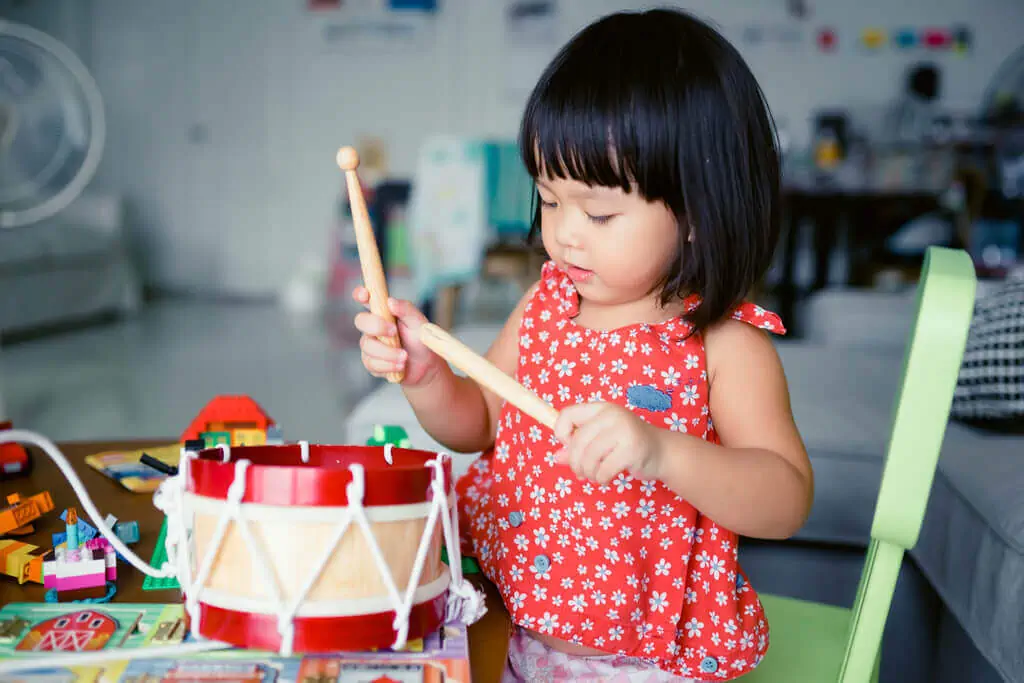
If you have little kids with high energy running around your living room, then safety should be your priority. Here are some tips to make your living room safe but enjoyable for the toddlers:
- Strap up your big appliances.
Children this age have no control of their energy that they tend to go overboard with their actions. Actions like these may topple over the television from its desk. - Keep your handheld devices out of reach.
Some handheld devices may be a choking hazard to infants. Keep them out of reach by placing them in high places or hiding them from your kids. - Use safety gates around your living room.
Prevent toddlers from entering areas in the house that are more dangerous than the living room, consider installing sturdy safety gates to keep them in the living room for safety. - Install carpets for extra safety.
As your infant becomes a toddler, your floor protection should improve as well. Toddlers tend to run around and slip, but at least they fall into something softer than hardwood or cement floors.
For kids (6-years-old to 12-years-old)

As the children grow older, their curiosity for many things piles up as well. Your condo living room is the source of many objects that may rouse their curious minds.
- Keep hazardous things out of reach.
Curiosity is fun and as much as you want the kids to learn, being close to injuries is never an option. So keep hazardous, pointy, and dangerous objects out of children’s reach. - Try doing what your kid does as well.
This means watching what they watch, playing what they’re playing, and listening to whatever they’re listening to. Keep your kids safe from watching or learning anything inappropriate by keeping an eye on the TV shows they watch. - Secure the furniture.
Doesn’t matter if your kids are clumsy or not, make sure that they’ll be secure if ever they bump into the furniture. - Inspect your furniture regularly.
Every now and then, check if they are still sturdy enough to be used on a daily basis. - Mind your houseplants -
While indoor plants can bring a new aesthetic and oxygen to the home, some plants can be hazardous, poisonous even, to children. Before putting plants in your home, make sure to check if these are safe for children.
For teenagers (13 to 19 years old)

Children this age spend more time outside of the house now, but that doesn’t mean you shouldn’t keep your home living room safe for them.
- Alcohol and drug-free haven.
The peer pressure brought about by the outside world may bring your teenage children into doing something their bodies are not ready for—like drugs and alcohol. In this case, make your living room a safe haven for teens. Make them understand the realities of these substances at a young age - Respect their privacy.
Privacy is something very important to teenagers (a sensitive topic, too) that they often want to spend time by themselves in their room. When they are staying in the living room, don’t shove your face into their cellphones or their “personal space.” Make them feel that the living room and the entire home is still a place where their privacy is respected.
For adults (20-years-old and above)

With age comes a slower immune system and restrictions in movements. Keep the living room safe for adults with these tips:
- Sofas should be back-safe.
The spinal cord is often hit first when growing old, so consider having sofas that can help the back relax rather than further damage the posture of most adults. Consider providing pillows that can help adults relax in the living room. - Check the doors and windows.
Always make sure to maintain the sturdiness of the doors and windows of your condo unit. This can help in the protection of your family members inside the unit - Anchor the television on the wall.
This is to avoid hitting the television while walking at home (and to save space, as well), consider mounting your TV unit to the wall instead of placing it on a cabinet. This is a safer option, especially if you have kids in the unit. - Install fire and security alarms.
Adults like you tend to become tired easily that you may forget some things. Keep your living room and the entire condo unit safe from any incidents by installing fire and security alarms that would warn you in case something happens.
For the senior citizens (50 and above years old)

When living with senior citizens, you must keep an eye on them at all times as they are prone to accidents. Show them some love by incorporating these safety measures in the living room:
- Install and set up good lighting.
Some of our senior citizen folks have terrible eyesight as they get older. Install lights bright enough to help them see better in the house - Add thin carpets for friction.
Your folks are also more prone to falling or slipping. They might lose balance and slip because of slippery floors. Make sure to tape the carpet to the floor to avoid tripping - Have strong and comfortable chairs.
Consider providing them with chairs with the right height so their feet can reach the floor easily
The living room must be a safe haven for all family members. With the right equipment and safety measures applied, you’re sure that everyone will be safe and sound inside your condo unit.
Chapter 10
A Condo Owner’s Complete Kitchen Safety Checklist
The kitchen may be where the refrigerator is, but it's also a place where many accidents can occur.
From cutting board catastrophes to anything as serious as a fire, your kitchens condos are hazard-prone areas that need meticulous checking.
Sometimes, these accidents arise from issues with the simplest solutions, so make sure to know exactly what you need to check for in terms of hazard-proofing your condo kitchen here.
A popular place in every home is the kitchen. After all, it is the heart of the home. It can, however, be the most hazardous place, especially for children. How can you make your kitchen safe?
To make your own cooking area meet the standard condo home kitchen safety checklist, you should be fully aware of every piece of equipment in the area In this article, we will break down every safety measure you should practice, in terms of using your condo kitchen.
Electrical Appliances
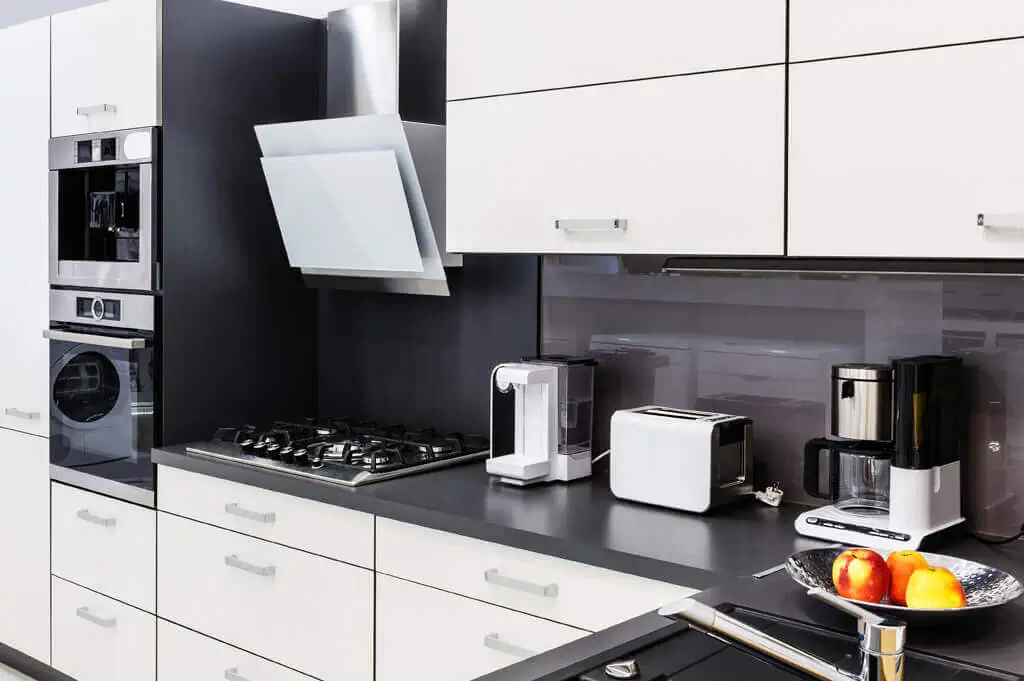
Electrical appliances are helpful as they make the work done easier and faster. Common electrical appliances are the microwave, blender, food processor, and fridge. Any other equipment found in your kitchen that runs on electricity falls under this category.
- Follow the safety instructions provided.
Usually, these pieces of equipment have a recommended way of storage, usage, and cleaning. Take time to read and follow the safety rules provided by the manufacturer, to avoid any unwanted accidents. If you do not follow these instructions, you could hurt yourself while using them, or you might damage them as a result of improper use. - Have damaged kitchen equipment repaired.
Regularly check the condition of your equipment. If you see that they need repair, or if they’re functioning in a funny way than they used to, then let a professional fix them. Call up the manufacturer, as they know the product inside-out - Keep heavy kitchen equipment away from your countertop.
Heavy equipment includes microwaves, toaster ovens, or other bulky appliances, like professional coffee makers, mixers, and whatnot. Keeping them away the countertop edges will prevent them from falling down to the floor if someone accidentally bumps into them. H - Don’t leave appliances plugged in all the time.
When you don’t unplug appliances, they consume extra energy, even though they’re switched off. Moreover, if you leave them plugged in, they might overheat and cause a fire to start. For tips on fire kitchen safety, keep this in mind. - Make sure plugs and switches are away from water sources.
If your kitchen is full of electrical equipment, then chances are you have electrical plugs and switches nearby. As a basic safety rule, remember to keep the sockets and plugs away from water sources such as the sink; so that you will not accidentally splash water on them. - Add electrical plug stoppers at home.
Children can get curious and tempted to touch even electrical plugs. Remind your kids never to touch them, especially if their hands are wet to avoid being grounded. To be completely sure of your kitchen’s safety, cover your unused electrical plugs with stoppers.
Cooking Stove

What’s a kitchen without a cooking stove? Most condo owners use electric stovetops and inductions cookers, while some still prefer gas stoves.
Certain cookware may be compatible with specific stovetops, depending on what you use. So when you use pots and pans, it is wise to think whether they will be compatible with your stovetop at home.
- Wash your hands when you prepare and cook food.
Make it a rule in your home to practice hygienic cooking. This will help keep your food from getting contaminated by germs and bacteria. - Keep your hair tidy and out of your face.
If you have long hair, tying it in a bun or a ponytail will help ensure that no part of it will touch the flames or the food you’re cooking. If you have bangs, clip it away from your face while you're cooking. - Use thick mitts when handling hot pots and pans.
Cooking will get hot. When coming close to a fire, take the extra measure, and wear cooking mitts. This is an essential safety tip to prevent burns that may happen. - Remember to turn the pot and pan handles inward.
The kitchen can get very busy. To avoid bumping into or knocking your pots and pans off your stovetop, turn the handles inward or away from the common or walking area - Prevent children and pets from running around the kitchen.
Since a condo is a small space, always remind your kids that the kitchen is not a place to play in at home. It might be the source of good-smelling food, but there are also hidden hazards when not approached with caution. - Keep away loose and flammable items from your stovetop.
Another item to add to your kitchen safety checklist is to make sure that your stovetop is clear of loose things such as hand towels and flammable items. When caught by the flame, these things can start a fire. - Have a fire extinguisher nearby.
To prevent small fires from escalating, especially because you live in a condominium building, always have a fire extinguisher that can easily be accessed in case of an emergency. Do not use water to put out grease fire. As a family, learn how to use a fire extinguisher. - Switch off your gas cylinders.
Leaks in your gas cylinders can pose as a fire hazard in your kitchen. After cooking and before sleeping at night, a safety tip to remember is to switch off your gas cylinders and make sure all stove knobs are switched off. Make sure that your gas regulator is always working properly. Be alert if you smell any gas leak in your home. - Keep the area organized and clean.
Kitchen safety and sanitation are both important. A disorganized cooking area can contribute to unwanted injuries at home such as a knife falling off a countertop or getting cuts from rummaging through a drawer full of sharp tools.
Wipe your stovetop and oven clean at the end of the day, as grease and other debris from what you cooked can ignite a fire. Cleaning your stove will also prevent pests from lingering in your kitchen.
Utensils

When handled improperly, utensils can become a safety hazard to the family. Below are a few kitchen safety tips you can follow:
- Don’t fool or play around.
Horseplay is one of the common reasons why accidents happen. As a kitchen safety tip for both children and adults, refrain from horsing around when you are cooking. If you’re using a knife, avoid pointing it at others. - Use the right utensil for the job. There are utensils designed for specific purposes. Make sure to use each for the right purpose. If not, you might damage the utensil and hurt yourself, in the process.
There are utensils designed for specific purposes. Make sure to use each for the right purpose. If not, you might damage the utensil and hurt yourself, in the process. - Clean each utensil thoroughly.
As much as possible, clean kitchen utensils with soap and water. Make sure to scrub all the crevices and nooks of each one to make sure no grease or small food debris remains on them. Rinse and dry them afterward. If you see that a utensil such as a plate or glass has cracks or chipped off edges, replace them. - Store your utensils properly.
Another kitchen safety tip to remember is sharp utensils should be kept away from children’s reach. Make sure that the storage compartment of these utensils are clean and dry; so as to avoid bacteria from growing in them. Make sure that no pests walk in the cabinets and drawers where you keep these utensils.
Furniture
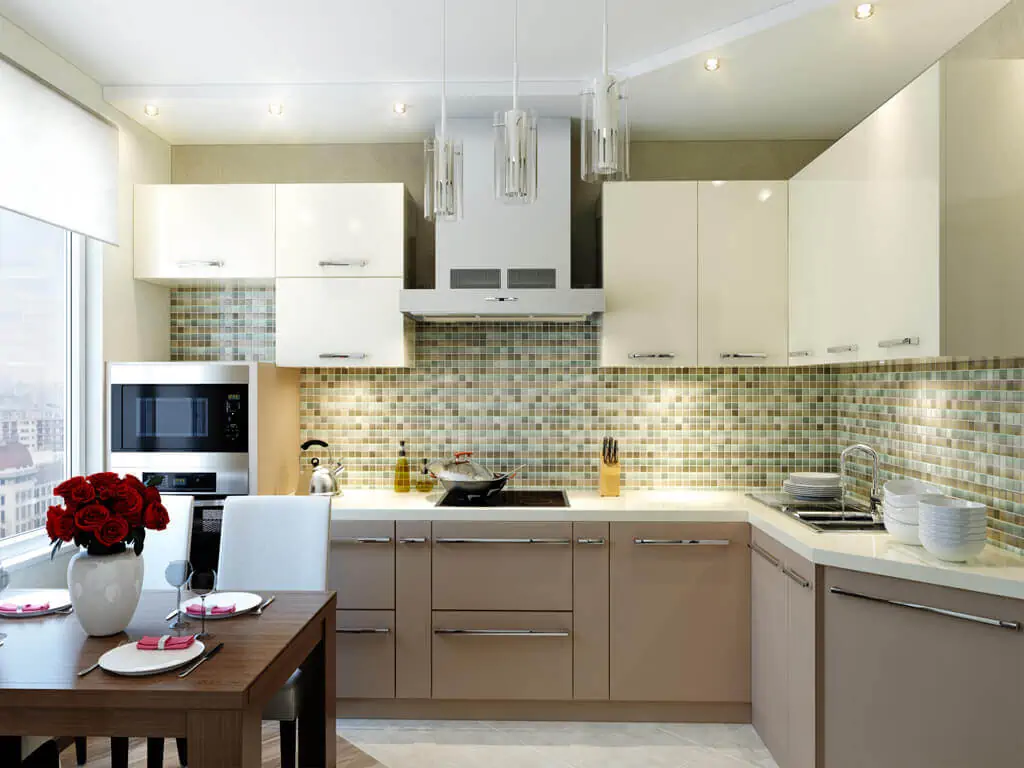
Furniture in the kitchen is usually made of wood, plastic, granite, and tiles. These surfaces are hard and sturdy and designed to be easy to clean and maintain. When granite and tiles are wet, though, they can get slippery; so caution must be exercised.
- Eliminate or cover sharp corners on countertops.
Another item you should check on your kitchen safety checklist is the edges of your tables and countertops. Choose furniture with round edges; so that if a child runs into them, it won’t be as painful as running into a sharp corner. Or, you can purchase edge covers at your local hardware shop. - Keep your kitchen surfaces dry and clean.
Once you’re done preparing and cooking food, clean and dry surfaces, as they can get slippery, especially if they’re made of granite or tiles. Teach and train your kids kitchen safety rules by letting them help you clean tables and countertops.
Flooring
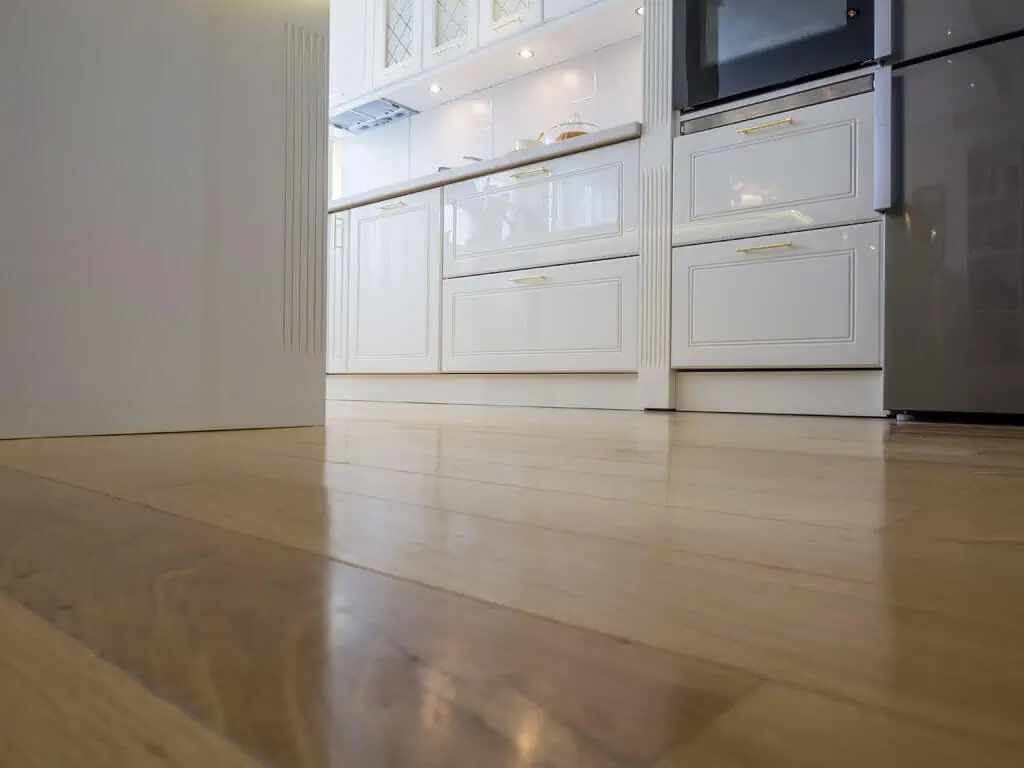
There are different durable options for kitchen flooring. Choose one that fits your style and budget. No matter how durable your flooring is, though, you should always clean and dry it to avoid accidents from happening.
- Place slip-resistant mats, especially near the sink.
Every condo kitchen should have a slip-resistant mat. The floors are prone to getting wet from cooking and washing. To avoid slipping and falling, make sure that you have slip-resistant mats in place. - Organize cords and wires.
Similar to your kitchen equipment and appliances, keep electrical cords, wires neat and organized. This is to prevent anyone from tripping at them while cooking. - Don’t leave toys lying around.
As a kitchen safety rule, don’t let your children leave their toys lying around the area, as you or others might accidentally step on them while you’re handling sharp utensils or holding hot food.
Practicing condo safety rules will not only keep you and your family safe but also keep those who live with you safe in the same building. Read and follow this kitchen safety checklist together as a family will help make your kitchen a real haven for all of you
Chapter 11
Quick Safety Reminders for Your Condo Bathroom
Accidents in the bathroom are as common as any, and sometimes can be the most dangerous, especially for young children and elderly members of the family.
But are the accidents caused just by a random puddle on the tiles? Definitely not.
This ultimate guide to condo bathroom safety will guide you in checking what needs to be checked and address in order to accident-proof the space!
The bathroom is the smallest room in a home or condo, but it provides us with the most privacy. For some people, it is a refuge where they can after a long tedious day. While others treat the space as a necessary room that they have to use as part of their daily routine.
No matter how you view your washroom, there are some bathroom safety and toilet cautionary measures that you should follow to avoid accidents. In fact, did you know that the bathroom can be the most dangerous part of a home?
This list will remind you of some bathroom safety tips you can follow to keep it a safe space for every member of your condo household:
General Bathroom Safety Guidelines
A study led by a pediatrician showed that 97.1% of bathroom-related accidents occur at home, with toddlers, children, and the elderly being the most susceptible age groups. The number one accident is slipping. Here are a few tips to keep your condo bathroom safe:
- Place a weighted shower curtain that will separate the shower.
Wet floors cause slipping. Always keep the comfort room floor dry. A weighted shower curtain that will separate the shower from the rest of the space in the bathroom will act as a barrier and keep water from scattering all over the floor. Invest in non-slip mats. - Invest in non-slip mats.
According to Injury and Violence Research, common rags may also cause slipping because they do not provide the necessary grip and firmness when people step on them when walking out of the shower. A non-slip mat will spare you the medical bills, especially if you have elderly members in your condo. These mats have taut undersides that don't easily slip, even if its surface is wet. - Provide proper lighting.
Poor lighting in your washroom may adversely lead to several accidents. Sunlight may provide sufficient lighting in the morning. Meanwhile, in the evening, incandescent, fluorescent, and halogen light bulbs give off the needed luminescence in contrast to LED ones whilst requiring lower energy requirements. - Keep calm and organize your toiletries and medicine.
The washroom is the place you go to clean yourself. This is why it’s important for you to keep it clean and orderly. Improper arrangement of your bathroom essentials may lead to accidentsMembers of your household may accidentally ingest the wrong medicine from the medicine cabinet or reach for a strong chemical used for cleaning stains than usual items such as shampoos, if not sorted out properly. Now, this may sound macabre and unlikely, but prevention is key to avoiding these bathroom accidents altogether - Make it a no-gadget zone.
Accidents don’t just happen with people. It could also occur to cell phones or portable gaming devices. These may easily slip from your wet and still soapy hands and break on the cemented bathroom floor—worse yet, in a bucket of water or even in the toilet itself. - Always unplug equipment.
Some bathroom equipment such as hair blowers, dryers, and lamps should never be left plugged in, to avoid electrocution. Put electrical items inside shelves or in a dry storage area away from water, when not using them. - Double-check equipment plugs.
Make sure that plugs are dry before inserting them into sockets, as plugging them in may cause short-circuiting. It may also be best to use your hairdryer in front of your vanity in the bedroom, and avoid bringing anything that runs using electricity in the bathroom. - Be mindful of the water heater.
Unchecked water heaters can cause scalding. This device is often overlooked and taken for granted because it is such a simple mechanism. With the usual heat level indicators such as "warm", "hot", or "very hot", it’s easy to forget that other members of the household also use the water heater with a different heat threshold compared to you.
Bathroom safety for Toddlers and Children
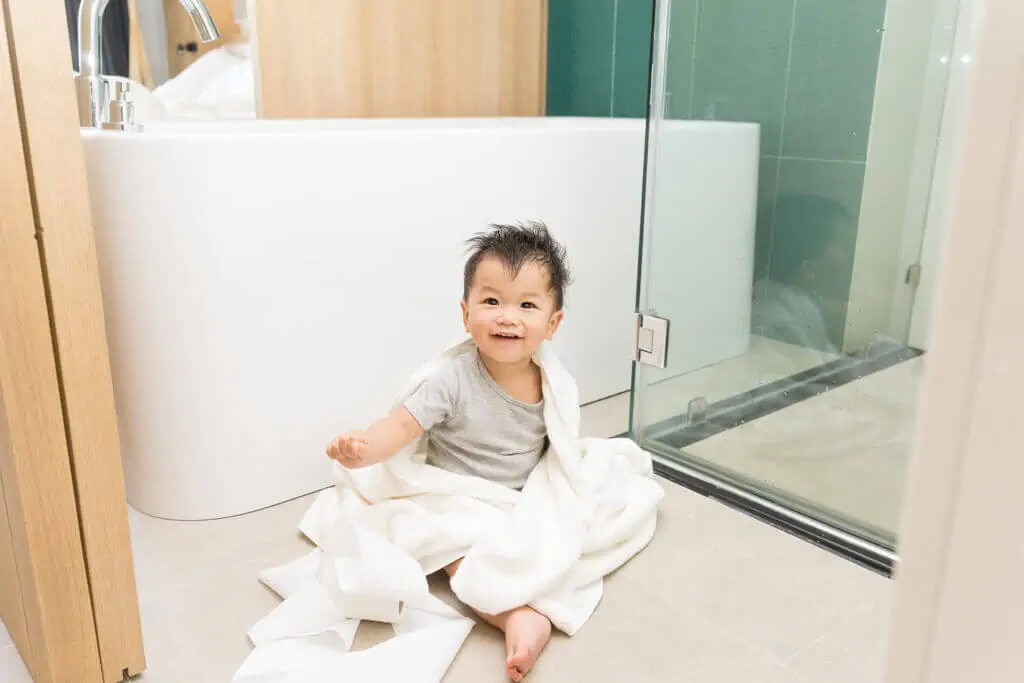
- Purchase a potty trainer.
Toddlers using the bathroom independently is often treated as a rite-of-passage. Let them practice, first, in potty trainers before letting them go on their own. Teach them how to properly clean their hands, as well. - Place baby-safety locks on your condo bathroom door.
Children may wander inside your condo and end up in the washroom alone where they could easily slip and hit their head. Keep them from accessing certain rooms by using baby safety locks. These locks keep doors and cover with hinges such as bathroom doors, cabinet doors, and the toilet seat covers from fully opening - Separate your items from your children’s.
Do not cram and mix your items and medicine inside the cabinets and compartments with your children’s belongings. They might accidentally use your prescription drugs and cause overdosing. Place their items in a separate shelf that they can easily reach, away from your belongings—which you should place higher than your child’s reach. - A small stool would be cool.
If your children are adeptly trained in bathroom etiquette and are physically big enough to go on their own, provide them with items that will help them access fixtures such as the sink more easily. - Provide children with different soaps and shampoos.
Children’s skin is still sensitive; and there are chemicals present in your soap and shampoo that might not be suitable for them. Always double check if the formula is safe for kids’ consumption, or ‘tear-free’ as they say.
Bathroom Safety for Seniors
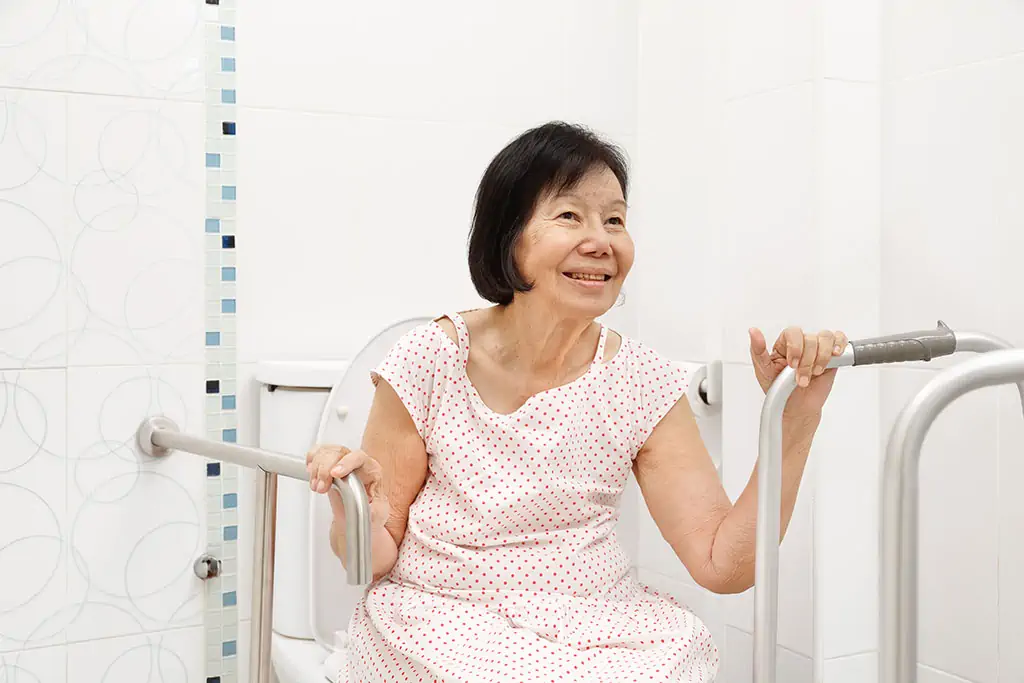
- Place grab bars in your bathroom.
Grab bars provide grip leverage and balance needed when walking on a wet floor. This could also be helpful for people who are always on-the-go. These are the same people who sometimes miscalculate how much force they have to exert on their feet when standing up from the toilet. A wet floor with traces of soap suds may spell disaster. Grab some grab bars for your bathroom, to get a grip on potential injuries. - Install toilet seat extenders.
Seniors find it difficult to stand up from a slumped position from a low toilet seat. Toilet seat extenders are a piece of bathroom equipment that will help them. The extender elevates the seat of the toilet, making it more ergonomic and friendlier for the elderly to use. - Get a designated medicine cabinet.
Invest in one that has a mirror on its door and has several compartments for various bathroom items. This will help you organize things while giving seniors easy access to their medicine. - Place water heater level markers.
Seniors sometimes cannot check the water level on their own because of the quality of their eyesight. Help them tell the current heat level setting by labeling each heat setting to help the elders read them better. You can further help them by making sure that you revert the heat level to normal after you shower. - Enable easier access to sanitary products.
Seniors might find it difficult to scoot down and look to reach the toilet paper or the bidet. Make sure that the toilet paper roll and bidet holder are immediately next to them.
These are simple reminders to help you avoid accidents inside your condo. Follow these bathroom safety tips to keep your condo a safe space for everyone in your family.